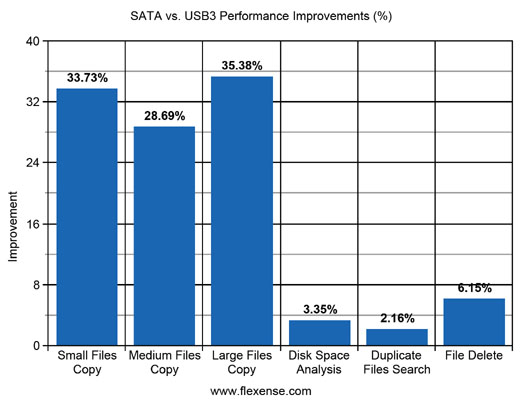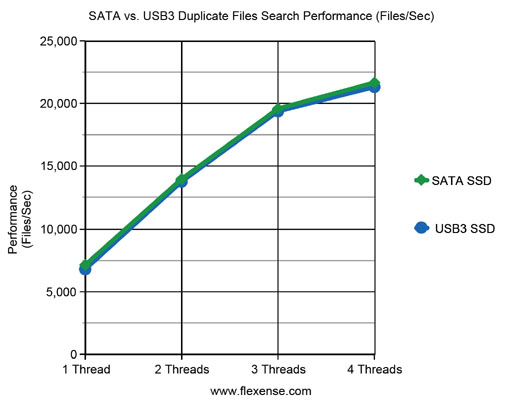USB3 vs. SATA Disk Performance ComparisonNormally, internal storage devices such as hard drives and SSD disks are connected to the computer via the SATA interface, which allows to transfer data up to 6 Gbit/Sec. On the other hand, external storage devices may be connected via a number of different hardware interfaces including the Universal Serial Bus (USB), Firewire, the Thunderbolt interface, etc. USB 3.0 increased the maximum transfer speed approximately ten times allowing to transfer data up to 5 Gbit/Sec and making the USB bus very useful for connecting external storage devices. The purpose of this review is to compare the performance of SATA3 vs. USB3 hardware interfaces with two identical SSD disks connected to the same computer. 
For this performance review we have performed a number of different file copy, file synchronization, directory scanning, file search, disk space analysis, file classification, duplicate files search and file delete performance tests using the following three different sets of files: small files, medium-sized files and large files. All tests were performed on exactly the same hardware platform, in the same order using the same sets of files using two identical SSD disks connected via the SATA3 and USB3 interfaces. Test Server Hardware Configuration
Test Data Sets
Performance Tests
All benchmarks were performed using DiskBoss v7.4 (64-Bit version), which is capable of performing different types of disk space analysis, file copy, file synchronization, file search and file delete operations. For all tested configurations, each test was performed 4 times using 1, 2, 3 and 4 parallel threads. File Copy Operations
When copying small files to/from an external USB3 SSD disk, the average file copy performance reaches 66 MB/sec for a single file copy thread and scales to 126 MB/sec for 4 parallel file copy threads. On the other hand, when copying the same set of small files to/from the same SSD disk connected via the SATA3 interface, the average file copy performance reaches 74 MB/sec for a single file copy thread and scales to 158 MB/sec for 4 parallel file copy threads. 
When copying medium-sized files to/from an external USB3 SSD disk, the average file copy performance reaches 134 MB/sec for a single file copy thread and scales to 320 MB/sec for 4 parallel file copy threads. On the other hand, when copying the same set of medium-sized files to/from the same SSD disk connected via the SATA3 interface, the average file copy performance reaches 170 MB/sec for a single file copy thread and scales to 526 MB/sec for 4 parallel file copy threads. 
According to our performance tests, for file copy operations the SATA3 interface delivers an approximate 30% performance improvement over the USB3 interface and the performance improvement is more pronounced when copying large files using a number of parallel file copy threads making the SATA3 interface more scalable for I/O intensive applications. Disk Space Analysis Operations
When scanning and analyzing directories, the performance of an external SSD disk connected via the USB3 interface reaches 50,000 Files/Sec for a single analysis thread and scales to 80,000 Files/Sec when scanning directories and analyzing files using 4 parallel processing threads. 
When scanning and analyzing the same set of files stored on the same SSD disk connected via the SATA3 interface, the performance of disk space analysis operations reaches the same 50,000 Files/Sec for a single analysis thread, slightly improves for 2 and 3 parallel processing threads and then scales to the same 80,000 Files/Sec when scanning directories and analyzing files using 4 parallel processing threads, resulting in a minor 3% performance improvement over the performance delivered by the USB3 interface. Duplicate Files Search Operations
When searching duplicate files, the performance of an external SSD disk connected via the USB3 interface reaches 6,800 Files/Sec for a single processing thread and scales to 21,300 Files/Sec when searching duplicate files using 4 parallel processing threads. 
When searching the same set of duplicate files stored on the same SSD disk connected via the SATA3 interface, the performance of duplicate files search operations reaches 7,100 Files/Sec for a single processing thread and scales to 21,600 Files/Sec when searching duplicate files using 4 parallel processing threads, resulting in a very small 2% performance improvement over the performance delivered by the USB3 interface. File Delete Operations
When deleting files from an external SSD disk connected via the USB3 interface, the performance of file delete operations reaches 15,800 Files/Sec for a single file delete thread and scales to 32,100 Files/Sec when deleting files using 4 parallel processing threads. 
When deleting the same set of files from the same SSD disk connected via the SATA3 interface, the performance of file delete operations reaches 17,100 Files/Sec for a single file delete thread and scales to 32,800 Files/Sec when deleting files using 4 parallel processing threads, resulting in a 6% performance improvement over the performance delivered by the USB3 interface. Conclusion
Finally, in order to be able to easily compare the USB3 interface to the SATA3 interface for all types of file management operations, we have averaged and normalized all performance results and calculated average performance improvements of the SATA3 interface over the USB3 interface. 
According to the average performance results for all types of file management and analysis operations, the SATA3 interface is approximately 30% faster for file copy operations, 6% faster for file delete operations and almost identical to the USB3 interface for all types of analysis and file search operations. * This review was prepared for information purposes only and we strongly recommend to test the performance of the DiskBoss file management toolkit on your specific hardware platform and with your specific data sets. |